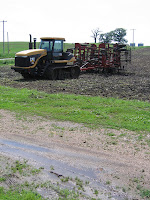The only thing I ever bought at auction was done over the phone and pretty much blind. I was bidding on a pivot irrigation unit that was sitting on our farm in Nebraska. (Long story.) I thought I knew what I wanted to pay for it, but the bidding shot by that ceiling pretty fast, and all of a sudden I felt like I was free falling with butterflies in my stomach. It wasn't a pleasant experience. I really didn't have enough information to make an intelligent decision.
Auctions can do that to you, I guess, if you're not prepared. Reading comments in an Agriculture Online discussion, What's your bidding style? makes me think that people tend to develop their own little techniques for coping with the experience. They look the auctioneer in the eye, they stand by big people, they bid quick, or they bid just before the gavel's about to fall.
One fellow may have hit it on the head, though: "The way I know I'm not overpaying is knowing what it's worth is before going to the auction...."
"Knowing what it's worth" is the mantra of Machinery Pete, Greg Peterson, who's built a business around the importance of knowing the real value of used machinery. In Greg's regular writings on Agriculture.com and Successful Farming, he provides detailed auction prices on all kinds of used machinery. And he gleans from those details the trends in equipment pricing.
His new book, Machinery Pete's 2010 Auction Price Guide is fresh off the press. It lists more than 18,000 sale prices from 2008-2009.
As Dave Mowitz, Successful Farming magazine machinery editor, says, "Take this book to auctions and bid with confidence. Take it to your banker to prove your net worth. This is the book you need if you own farm machinery."
Wish I'd had a copy of Pete's book the day I bought that pivot.
Here's where to get yours: Machinery Pete's 2010 Auction Price Guide.


